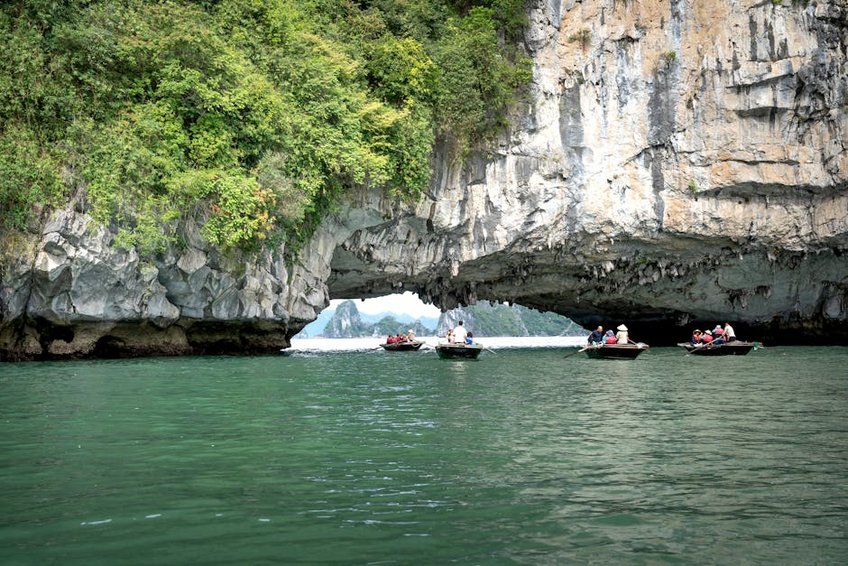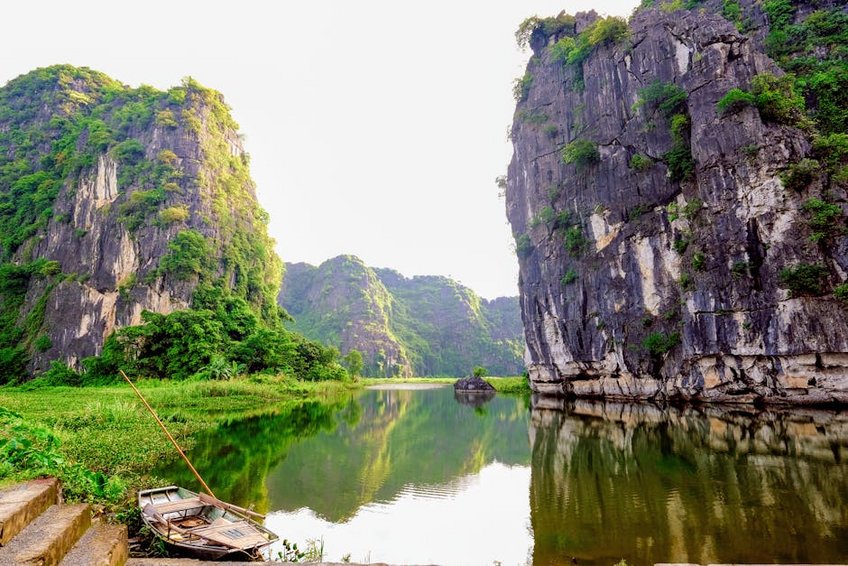Vietnam Phong Nha Cave System: Ultimate Underground Adventure
Exploring the Vietnam Phong Nha Cave System immerses you in the planet’s most spectacular karst landscapes and colossal underground chambers. This UNESCO World Heritage site features over 300 caves, including Son Doong, the world’s largest cave, with its own jungle ecosystem and weather patterns. Your adventure spans illuminated river passages, ancient rock formations, and jungle trekking through Phong Nha-Ke Bang National Park’s protected wilderness.
Essential Information About Phong Nha
Phong Nha-Ke Bang National Park covers 1,236 square kilometers in Central Vietnam’s Quang Binh Province. This karst formation dates back 400 million years, creating Southeast Asia’s oldest major limestone area. The park’s biodiversity includes 800 vertebrate species and 2,700 plant types thriving in its tropical climate.
Local communities have known these caves for centuries, with Phong Nha Cave appearing in historical Nguyen Dynasty records. British explorers documented the system in the 1990s, leading to Son Doong’s 2009 discovery. Modern conservation balances tourism with protecting fragile calcite formations and underground rivers.
Geological History and Formation
These limestone caves formed through water erosion over millions of years across different geological periods. The karst landscape developed during the Paleozoic era, particularly the Carboniferous and Permian periods. River systems carved massive chambers while mineral deposits created spectacular stalactites and stalagmites.
UNESCO World Heritage Status
UNESCO designated Phong Nha-Ke Bang a World Heritage site in 2003 for its outstanding geological values. The recognition highlights the area’s exceptional karst topography evolution and significant geomorphic features. This protection ensures sustainable management of the cave systems and their unique ecosystems.
Climate and Environmental Conditions
The region experiences a tropical monsoon climate with distinct wet and dry seasons influencing cave accessibility. Temperatures range from 59°F to 95°F (15°C to 35°C) annually, with higher humidity during summer months. The rainy season from September to December affects water levels in river caves and some tour operations.

Alt: “phong-nha-cave-system-son-doong-entrance-jungle”
Vietnam Phong Nha Cave System – Planning Your Trip
Organizing your Vietnam Phong Nha Cave System adventure requires careful timing between February and August for optimal conditions. The dry season offers better trekking conditions and lower river levels for cave access. You’ll need 3-5 days minimum to experience multiple caves while accounting for weather variations in this tropical region.
Budget approximately $800-$2,000 per person depending on your chosen cave experiences and accommodation style. This estimate includes guided tours, transportation from Dong Hoi, and national park fees. Booking tours 3-6 months in advance is essential, especially for Son Doong expeditions with limited annual permits.
Best Time to Visit Phong Nha Caves
Visit between February and April when temperatures range from 68°F to 82°F (20°C to 28°C) with minimal rainfall. These months provide ideal conditions for cave exploration and jungle trekking without extreme heat. May through August brings warmer weather up to 95°F (35°C) but remains suitable for most tours.
The rainy season from September to January sees heavy precipitation that can flood some caves and cancel tours. However, this period offers lush green landscapes and fewer visitors for those willing to risk weather disruptions. Check specific cave accessibility as conditions vary daily during wet months.
Budget Planning and Costs
Your expenses will vary significantly based on which caves you explore and your comfort preferences.
- Budget travelers spend $30-$50 daily for hostel stays, local meals, and public caves like Phong Nha and Paradise Cave without guided tours.
- Mid-range visitors allocate $80-$150 daily for comfortable hotels, organized day tours to Dark Cave or Nuoc Nut Cave, and better dining options.
- Luxury experiences cost $250-$500 daily including boutique resorts, multi-day caving expeditions, and specialized adventure tours with professional guides.
- Phong Nha-Ke Bang National Park Official Website
- Oxalis Adventure Tours – Official Cave Operator
- UNESCO World Heritage Centre
Essential Preparation Checklist
Pack quick-dry clothing, sturdy waterproof hiking shoes, and headlamps with extra batteries for dark cave sections. Include swimwear for river caves, insect repellent for jungle areas, and waterproof bags for electronics. You’ll need broken-in footwear comfortable for walking on uneven surfaces and through water.
Secure comprehensive travel insurance covering adventure activities and potential tour cancellations due to weather. Check Vietnam visa requirements for your nationality, as most visitors need pre-arranged authorization. Book reputable tour operators through their official websites or trusted platforms like TripAdvisor.
Top Attractions and Cave Experiences
Phong Nha offers diverse cave adventures from easy river tours to challenging multi-day expeditions deep underground. The system’s scale ranges from massive cathedral-like chambers to intimate grottos adorned with spectacular formations. Each cave presents unique geological features and requires different fitness levels for proper exploration.
Local tour operators provide equipment and expertise for safe navigation through these fragile environments. You’ll encounter everything from zip-lining into cave entrances to swimming through underground rivers illuminated by headlamps. The variety ensures memorable experiences whether you prefer gentle sightseeing or adrenaline-fueled adventure.
Must-See Cave Highlights
Son Doong Cave represents the system’s crown jewel, requiring special permits and 4-day expeditions costing $3,000 per person. This colossal chamber could contain a 40-story skyscraper and features its own jungle ecosystem with unique wildlife. Access remains limited to 1,000 visitors annually through Oxalis Adventure Tours, the exclusive operator.
Paradise Cave showcases breathtaking stalactite formations across its 31-kilometer length, with 1 kilometer accessible to general visitors. The illuminated wooden walkway reveals cathedral-like chambers with minimal physical effort required. Arrive early to avoid crowds at this popular site open year-round except during severe weather.
Phong Nha Cave offers the most accessible experience via boat tours along the Son River into dramatic limestone passages. The 7,729-meter system features spectacular rock formations and historical Cham inscriptions dating back centuries. Combine this with the nearby Tien Son Cave for a comprehensive half-day introduction to the area.
Hidden Gems and Local Favorites
Dark Cave provides adventurous activities including zip-lining, mud bathing, and swimming through its unlit chambers. This interactive experience lasts 3-4 hours and includes all necessary safety equipment for families and thrill-seekers. The mineral-rich mud pools offer unique skin treatments amid complete darkness.
Nuoc Nut Cave remains less crowded while featuring an emerald underground river perfect for swimming and kayaking. The 2-kilometer system includes both dry and wet sections with impressive stalagmite formations. Local guides share fascinating stories about the cave’s discovery and ecological significance.
Adventure Activities and Tours
Multi-day caving expeditions range from moderate 2-day tours to challenging 4-day adventures deep into remote cave systems. These experiences include camping inside massive chambers, preparing meals with local ingredients, and expert geological interpretation. Physical requirements vary, with some tours involving rope climbing and swimming through underground rivers.
Jungle trekking connects various cave systems while revealing the region’s rich biodiversity and scenic landscapes. Guided hikes traverse primitive forests, mountain passes, and river crossings between cave entrances. The trails offer opportunities to spot rare wildlife like the Sao La antelope and numerous bird species.
Practical Travel Information
Reaching Phong Nha involves flying to Dong Hoi Airport (VDH) from Hanoi or Ho Chi Minh City, then transferring 45 minutes by road. The national park sits approximately 500 kilometers south of Hanoi, accessible via overnight trains or buses taking 9-10 hours. Once there, organized tours provide transportation between caves and accommodations.
Accommodation options span basic homestays to luxury resorts, with most clustered in Phong Nha Village near the park entrance. The village infrastructure has developed significantly with restaurants, tour agencies, and convenience stores catering to international visitors. Electricity and internet service remain reliable throughout the area.
| Accommodation Type | Features and Location | Price Range (USD/Night) |
|---|---|---|
| Hostels & Homestays | Basic rooms, shared facilities, village location, social atmosphere | $8-$20 |
| Mid-Range Hotels | Private bathrooms, air conditioning, swimming pools, tour booking services | $30-$80 |
| Boutique Resorts | Riverside locations, spa services, restaurant quality dining, organized activities | $100-$200 |
| Luxury Eco-Lodges | Sustainable design, jungle views, premium amenities, private guides available | $250-$400 |


